Eurotronic StellaZ Thermostatic valve test
Eurotronic is offering for some time thermostatic valves for smarthome integration, called Stella models. They can replace standard thermostatic valves on your radiators. Different models exist integrating different protocols: proprietary protocol, enocean, KNX RF, Zigbee, Zwave. The last letter of the product name is indicating the protocol used.
We will focus on Zwave version in this post, version named StellaZ.
There are only few product of this type on th market. The StellaZ is a competitor for Danfoss Living Connect 014G001. However, they are quite different.
Packaging
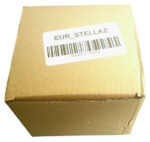 The packaging is basic, to say the least : noname box with a label on top.
The packaging is basic, to say the least : noname box with a label on top.
The set is containing :
- Thermostatic valve
- beige adapter for radiators with Danfoss valve type
- various other black plastic adapters for other formats that can be found on a radiator.
 Note the rather average finish of these adapters : they are joined to each other when received and breaking bonds reveals imperfections on those adapters
Note the rather average finish of these adapters : they are joined to each other when received and breaking bonds reveals imperfections on those adapters
Having my share of Danfoss valves type I have not had to use the others kind of adapters - a screw and nut necessary for two black adapters
- a key with two teeth to remove the valve from the radiator
- A user manuel (A4 dual side printed page) available for download using the following link
Presentation
Let’s start by having a look on this thermostatic valve :
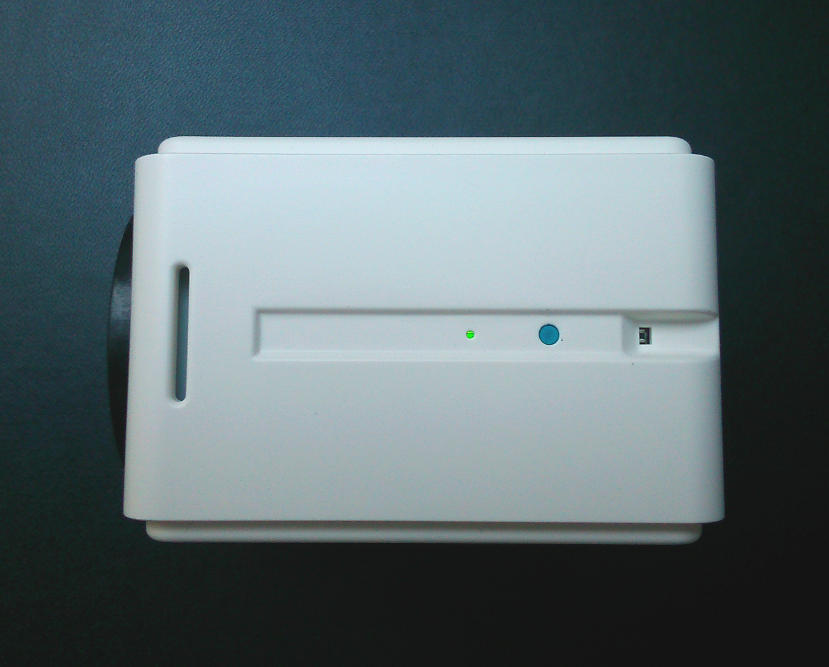 |
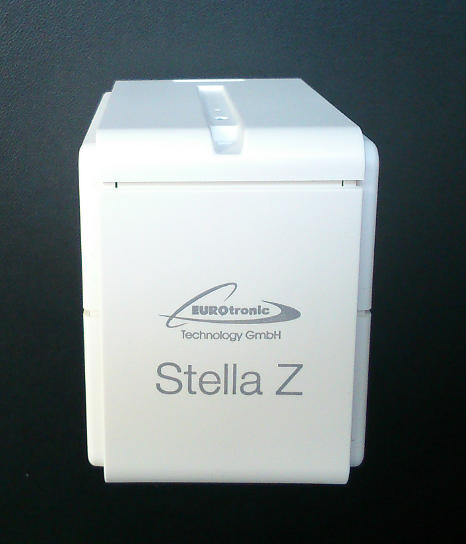 |
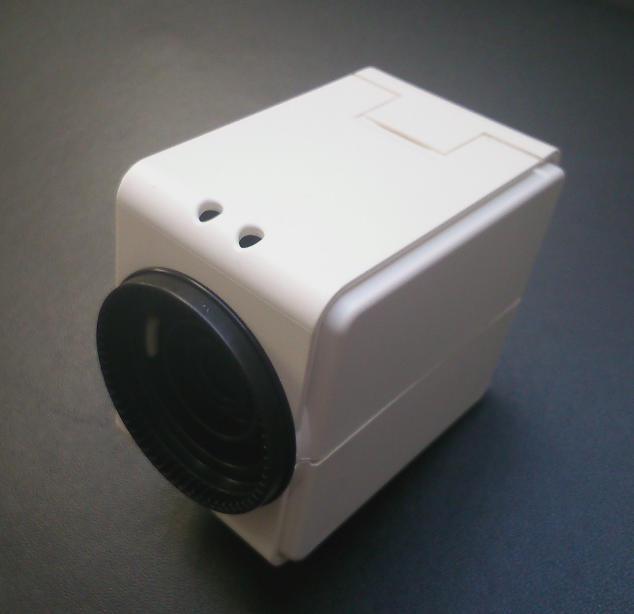 |
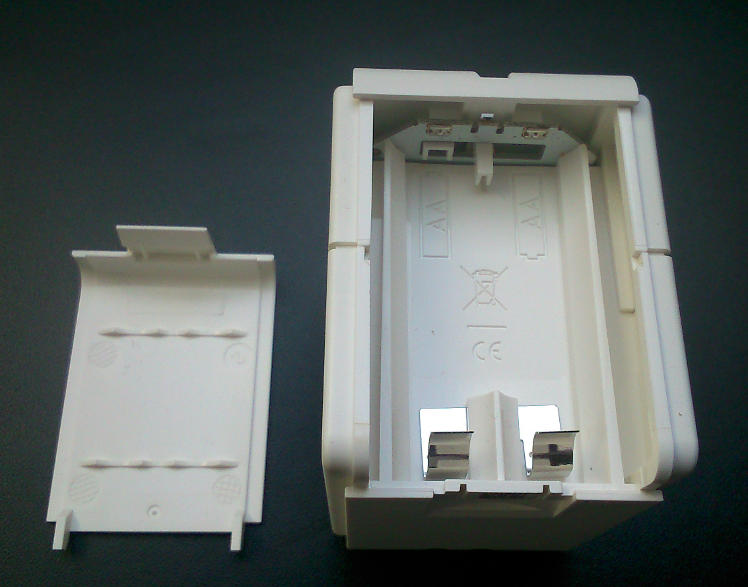 |
Located on the top is the standard duo button + led for pairing and other network functions. We can also see a small hole in which an electronic component appears : it should be the thermistor used to measure the ambient room temperature.
On the front are presented the labels for the products with EuroTronic logo and unit name. The layout of this display on the most visible face of the device is not a good idea. Fortunately these inscriptions are gray , they are then barely visible.
On the front is also the access door to the batteries, as it is indeed a battery operated device. Unfortunately the hatch seems rather fragile (be careful not to break the two small arms) . Same conclusion on the battery contacts that looks like really first price. Be careful also when inserting the batteries, there is no physical keying. The orientation of the batteries is engraved at the bottom of the container , but it is not obvious to see it.
 Few things appear on the bottom of the thermostatic valve apart from the door clip and two holes. These two holes are used with the two-teeth key to disconnect the valve from radiator. This key is actually discarding two tabs that appear on the photo at the right. These are the ergos that secure the thermostatic valve to the aforementioned adapters. These pins do not give the impression of a large strength in regards of the significant pressure that will be applied to them when resting on the radiator valve tap .
Few things appear on the bottom of the thermostatic valve apart from the door clip and two holes. These two holes are used with the two-teeth key to disconnect the valve from radiator. This key is actually discarding two tabs that appear on the photo at the right. These are the ergos that secure the thermostatic valve to the aforementioned adapters. These pins do not give the impression of a large strength in regards of the significant pressure that will be applied to them when resting on the radiator valve tap .
On the overall finish is just ok , with very visible and not very graceful plastic sockets.
Montage du thermostat
Mounting the thermostatic valve is relatively simple, at least in the case of using the adapter for Danfoss valves type. For pairing, this is still the duo button + LED to be used, like the majority of Z-Wave devices, so it is not very ergonomic. After a few tries, you get it working …
Note that it is important to put the thermostatic valve in a specific mode to connect to radiator : it totally fit the piston inside the unit to ease mounting.
Once the installation and pairing is done, we are in the presence of an automatized radiator :
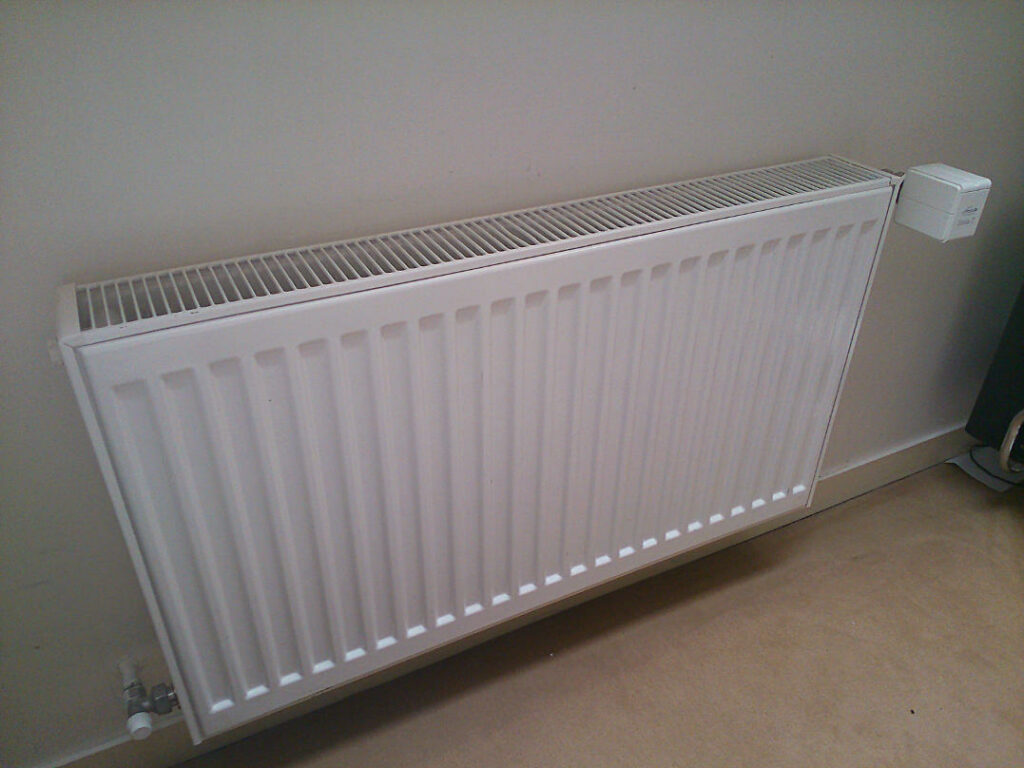 |
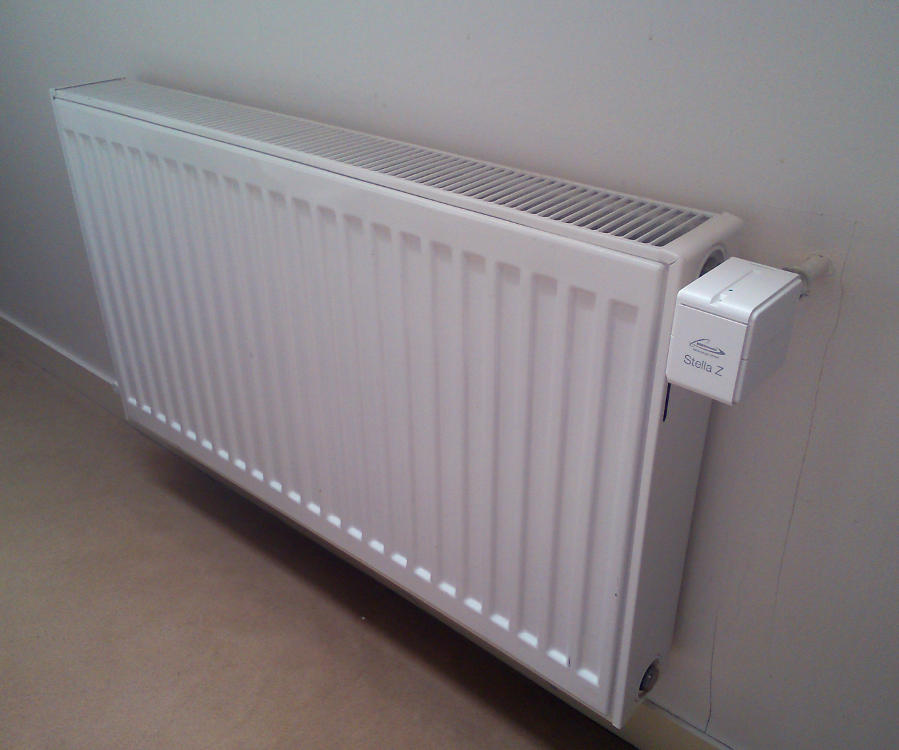 |
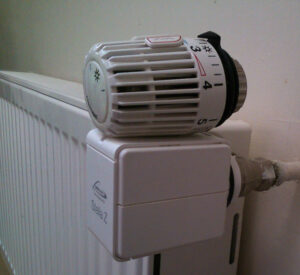 Visually, I’m not very pleased with StellaZ integration. However opinion of the family is better than mine, I received a general approval. Reality is that the thermostatic valve is still quite small in regards to room size. Have a look to the picture at the right for a visual comparison with a standard thermostatic valve. The size is similar, but the Eurotronic unit is necessarily more angular and more imposing.
Visually, I’m not very pleased with StellaZ integration. However opinion of the family is better than mine, I received a general approval. Reality is that the thermostatic valve is still quite small in regards to room size. Have a look to the picture at the right for a visual comparison with a standard thermostatic valve. The size is similar, but the Eurotronic unit is necessarily more angular and more imposing.
StellaZ with Veralite controller
The installation of this device with Veralite is done as usual. Control panel of StellaZ peripheral give acces to those parameters :
 Working mode ( Comfort mode or Economy mode)
Working mode ( Comfort mode or Economy mode)- set point configuration
- ambient temperature
- Battery level
An inaccuracy issue is due to veralite, because this controller is removing decimals for Zwave peripherals. Comparing ambient with set point is still possible but with a precision of 1°C.
Direct control of valve position in percent is not directly possible. It may be however possible to find some workaround by developing a luup script to do it.
StellaZ with Eedomus controller
Installation of StellaZ with Eedomus is done very easily. After it we have access to two panels that give access to set point for one and display ambient temperature for the other :
Battery level is available also into peripheral setting panel.
Working mode, direct control of valve position in percent can’t be managed.
Ambient temperature is correctly displayed by eedomus controller, but accuracy is limited to 0,5°C. This time, this is not an eedomus controller limitation but one from StellaZ valve which have a measurement precision of ±0,5°C.
Comparing functions
The Eurotronic thermostatic valve has many features through the Z-Wave network. It is clearly providing more functions than its counterpart Danfoss unit :
| Configuration Eurotronic StellaZ onVeralite |
 |
| Configuration Danfoss Living Connect 014G0012 on Veralite |
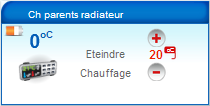 |
Here is a comparison of features availables depending of units :
| Thermostatic valve | Stellaz Support | |||
| Stella Z | Danfoss | Veralite | Eedomus | |
| Temperature setting point | Yes | Yes | Yes | Yes |
| Measured ambient temperature |
Yes | No | Yes (accuracy 1°C) | Yes (accuracy 0,5°C) |
| Battery level | Yes | Yes | Yes | Yes |
| Opened window detection | Yes | Yes | – | – |
| Comfort mode | Yes | Yes | Yes | No |
| Eco mode | Yes | No | Yes | No |
| Antifrost mode | Yes | No | Yes | No |
| Direct control of valve mode (in %) | Yes | No | No | No |
Lack of different modes on Danfoss device is not necessarily important, since the temperature can be directly changed. At the opposite the ambient temperature measurement on StellaZ is very interesting , even if this is not very accurate because taken near the radiator. This is a good indicator of the need for heating the room . A direct comparison between the setpoint temperature and the measured temperature can be used to trigger the boiler for supplying heat in a particular room.
Finally it should be noted that direct control of the valve position is possible. This feature can for example find sense in an advanced control sytem. For instance : the zone control of an underfloor heating .
Unfortunately Veralite is not able to use this mode, it has not been possible to test it.
Test results
Thermal regulation
After installing StellaZ valves, the feeling about temperature regulation is very good. With a setting to 20 ° C wind chill is almost constantly at an ideal level, neither too hot nor too cold in both rooms that are now equipped. The temperature stability is greatly improved compared to conventional thermostatic valve previously installed, comfort is improved.
By adding a temperature sensor (Oregon Scientific) in a room, I was able to verify that this impression is reflected by measurement :
- The black curve corresponds to the temperature in the room equipped with Stella .
- The green curve corresponds to the temperature in the living room which can be used to detect the heating off periods during the night. If the central heating is switched off , the thermostatic valved obviously can not raise the temperature in the room
- The blue curve is the temperature measurement provided by the Stella Z. It has a limited 1 ° C precision due to the Veralite accuracy. One can see for example that the opening of a window has an impact on the room temperature but can also be detected using the temperature measurement of the valve.
The regulation can generally be considered good : about + / – 0.2 ° C change in 10 hours.
All in all I’ve got the feeling that the regulation is better than the thermostatic valve from Danfoss . However, these units are located in different rooms with different constraints . It is therefore difficult to give a definitive conclusion at this level.11
 Consumption
Consumption
Now, what about the battery drain of StellaZ ? I recall that the unit operates using two AA batteries.
Firstly, I have noticed that the battery level measurement works correctly even if the given level with new batteries is 111% …
The battery level after 80 days is 83%. this is around 2,5% decrease each week. This would give a battery lifetime of about 10 months. From my experience with Danfoss thermostatic valve, this period should however be greater than this value. The wear rate is decreasing during lifetime. We can probably expect a lifetime of about 1 year. To achieve this figure you must however take care about two things : putting a low level setpoint in summer (7 ° C) when the heating is off to limit regulation movements, and limit waking periods of the valve.
Conclusion
+ Good room temperature regulation
+ Ambient temperature feedback
+ Correct battery lifetime
– ambient temperature precision of ±0,5°C
– long term reliability to be checked. Regarding some visual aspects, we may encounter some problems (battery contact problem for instance)
– thermostatic valve finishing is just acceptable
– Packaging and accessories are not qualitative
Update 2014-04-24 : Adding information when used with eedomus, update about battery lifetime

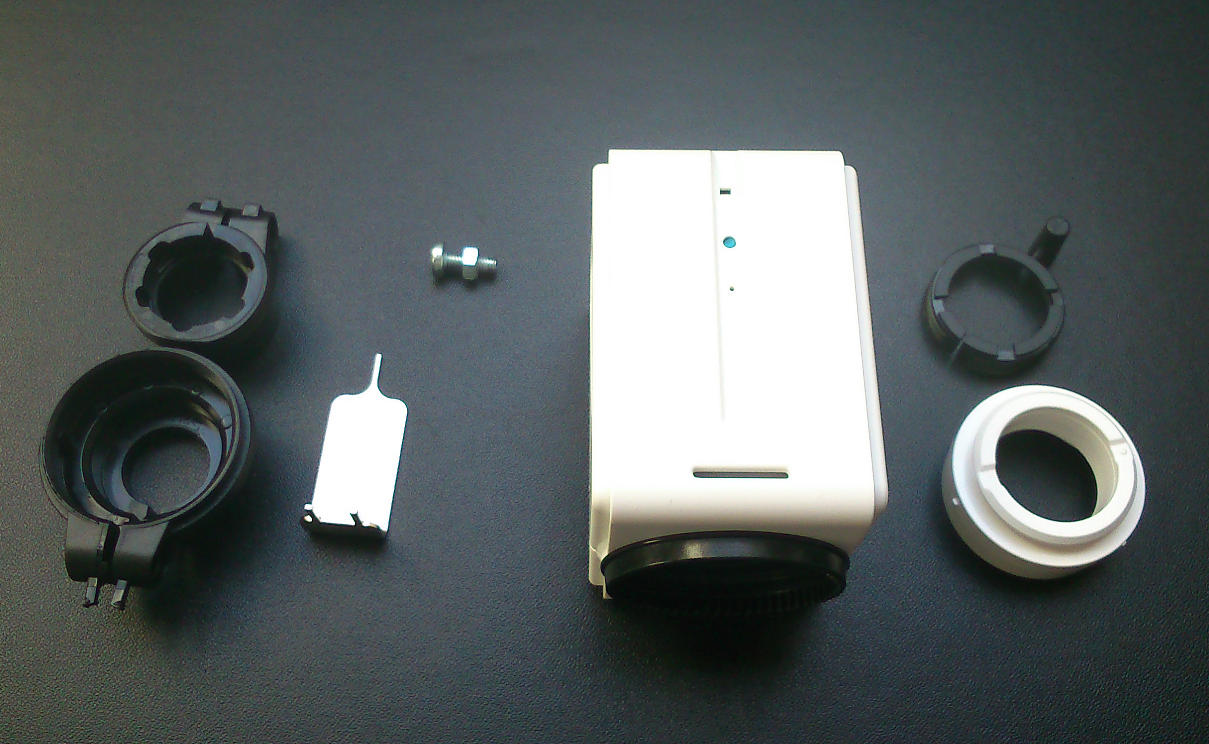

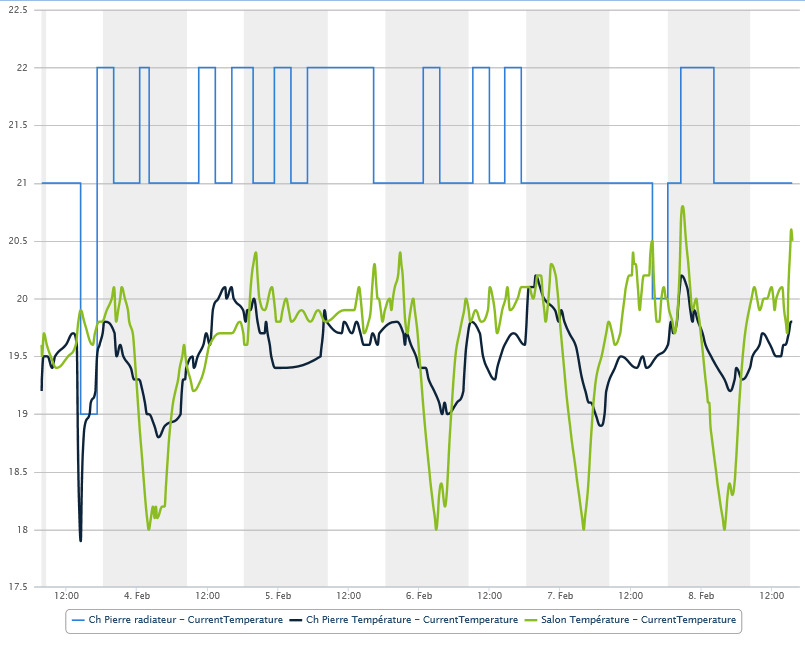



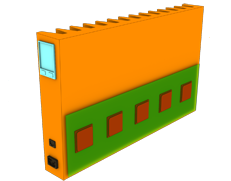
Adaptateur M28 dans la partie accessoires :
http://www.domadoo.fr/fr/peripheriques/2361-eurotronic-vanne-thermostatique-z-wave-stellaz.html
Merci pour l’information, j’ai ma solution. 11€90 à comparer au prix de la tête thermostatique ça fait cher, mais quand on a pas le choix…
Bonjour Vincent, merci pour votre article.
Pourriez-vous me dire si vos différentes vannes tiennent toujours le coup ? La qualité de fabrication fait réfléchir … Le clapet des piles semble vraiment fragile. Et surtout les adaptateurs sont ils toujours intacts ?
Je suis intéressé par ces vannes car les danfoss ne semblent pas compatible avec le logiciel domoticz, plusieurs utilisateurs s’en plaignent et malgré l’open source il faut avoir le temps de se plonger dedans afin de régler les quelques soucis.
Merci d’avance pour votre réponse !
Bonjour,
Elles ont fonctionnées 2 ans sans difficulté (2 changements de pile), Je n’ai pas eu de problèmes et la connection Zwave est plutôt (très peu d’erreur de transmission) surtout si je compare à la tête Danfoss.
J’ai déménagé et me retrouve malheureusement à présent avec des robinets avec filetage en M28 au lieu de M30, je n’arrive plus à les monter et ne les utilise donc plus temporairement. Si quelqu’un a une solution !
mais dans le cas de l’utilisation de Danfoss Living Connect, la chaudière est toujours en marche ?
Comment peut-elle se couper quand aucun des thermostat est en demande, la chaudière ne peut pas le savoir, non ?
Je pensais que ce système Living Connect se connectait sur une chaudière. Effectivement ce n’est pas le cas. La régulation par les robinets seulement est possible mais il me semble que gérer le démarrage / arrêt de la chaudière est un gros + en terme d’optimisation énergétique !
Bonjour,
Est-il possible d’associer cette tete thermostatique avec Jeedom ou Domoticz sur Razberry? Merci.
Désolé je ne peux pas répondre, je n’ai pas Domoticz…
bonsoir merci pour votre dossier :), je débute et j’aimerai commencer par gérer mon chauffage…et j’ai quelques questions, s’il vous reste un peu de temps…
À partir de l’Eedomus+, je voudrais savoir si je vais pouvoir gérer une Sonde thermomètre – OREGON SCIENTIFIC THN132N couplée avec plusieurs têtes thermostatiques Eurotronic StellaZ sur mes radiateurs a eaux afin de régler la température générale d’une pièce ?
je crois que c’est votre configuration… manquera t-il quelque chose pour faire marcher la chaudière en cas de besoin dans une pièce ?
est-ce que j’aurais le même résultat avec les danfoss ?
merci de votre retour !
Les têtes remontent déjà les températures, la sonde de température est-elle nécessaire ? Par ailleurs les têtes thermostatiques se commandent avec une consigne de température, pas avec une consigne type tout ou rien. Il suffit donc d’indiquer la température souhaitée à la tête thermostatique,et de mettre des règles pour changer ces températures en fonction du jour et de l’heure.
Le deuxième point concerne la chaudière et sa mise en route pour réchauffer une pièce qui serait trop froide. Comment est contrôlée votre chaudière, avec un thermostat mural basique? Quelle est l’année de la chaudière ?
Dans des installations un peu ancienne, il suffit de remplacer le thermostat mural par un module de contrôle ON/OFF ( fibaro, Qubino, aeon,…). Le contrôle du module peut être effectué par un thermostat virtuel sur eedomus pour les pièces n’ayant pas de robinet thermostatique commandé ( et donc retour de la sonde de température …). Cela peut se faire également par des règles de comparaison entre la consigne des têtes thermostatiques et la température mesurée de la pièce : si la température de la pièce est inférieure à la température de consigne, alors je démarre ma chaudière pendant 5 minutes.
J’avais ces règles en place. Dans quelques jours déménagement, et plus d’automatisation dans ma nouvelle maison du fait de la chaudière à condensation. Les thermostats d’ambiance utilisent un protocole propriétaire, ce n’est plus un simple ON/OFF :-(.
Sinon il y a la page d’aide eedomus à ce sujet :
http://doc.eedomus.com/view/Pilotage_du_chauffage
http://www.eedomus.com/fr/guide-pratique-comment-realiser-un-thermostat-personnalise/
En espérant que cela puisse aide.
Merci sur l’article et surtout de faire part d’une utilisation de 80 jours de test ! A partir de l’image, Stella n’offre pas la possibilité de modifier/visualiser la consigne du thermostat en local comme Danfoss LC ou Honeywell evohome. Pour une installation familiale en maison/villa cela me semble être important de pouvoir modifier la consigne car on n’a pas toujours l’accès à “la box” sous la main. Qu’en dit votre expérience ?
Mon avis est plutôt l’inverse : je ne vois aucune raison de modifier la consigne sur le radiateur. J’ai un thermostat danfoss également et nous ne touchons jamais la consigne. Les changements de consigne (jour/nuit) sont gérés par la box domotique d’une part ce qui veut dire qu’un changement manuel est de toute façon écrasé au changement de période. D’autre part on s’attend à ce que la régulation fonctionne, ce qui est le cas dans une maison moyennement isolée (maison des années 90)
I was trying to connect one of these this weekend. I thought it screwed on. I did not try putting in any batteries. Looking at this it appears that the device connects itself after the batteries are put in and you have placed it on the radiator valve. Is this the case?
You shouldn’t install it before putting batteries. Installation mode have to be activated which is retracting fully valve actuator to ease installation and prevent damages (refer to manual to do so, if I remember well you have to long press the button during 5 seconds). That’s first point. After installation, same button have to be long-pressed another time to end-up installation procedure, and it should go then in pairing mode automatically for a limited amount of time. For the Zwave pairing to happen you have also to have your controller to be in pairing mode …
If problems, try to remove pairing and do it again following the procedure in the manual.
Merci, je cherchais justement un article sur la StellaZ et je tombe sur -non pas un article – mais un véritable dossier de fond et qui plus est de qualité. On sent le métier et une grande maîtrise du produit. Avec mes remerciements
Enfin un avis complet et détaillé sur cette tête et une comparaison avec la Danfoss ! Merci mille fois.
Question : n’as-tu pas rencontré de problème d’encombrement du réseau Zwave ? Voire de communication avec la box ? Certains utilisateurs ont relevés des problèmes de communication qui peut être du à la masse métallique du radiateur.
J’ai rencontré et je rencontre toujours des petits soucis qui semblent liés au réseau Zwave en général : latence de commande la plupart du temps, ds distances maximales de connexion trop courtes dès qu’il y a 1 ou 2 murs (je dirais 1 dizaine de mètre maximum), un détecteur Aeon qui ne voulait plus discuter.
Mais rien de particulier relatif à la tête Eurotronic ou même Danfoss.
D’ailleurs comment ces utilisateurs ont vu que le problème était dû à la masse métallique du radiateur? Effectivement ça doit faire un bel écran pour le 868MHz mais il ne faut pas avoir de chance pour que la box et tous les éventuels répéteurs du réseau soient tous cachés par le radiateur…
Pour être clair je ne sais pas dire aujourd’hui si mes petites anicroches sont liées vraiment au réseau Zwave où à la box veralite (antenne pas terrible, méthode de gestion du réseau). Il faudrait passer du temps pour comprendre vraiment ce qui se passe. Mais la première étape serait de tout remettre à plat : supprimer tous les devices du réseau et les réappairer à leur position définitive de façon à être sûr de toutes les configurations. J’ai pas mal bricolé jusqu’ici, j’apprend par mes erreurs et il doit en rester.